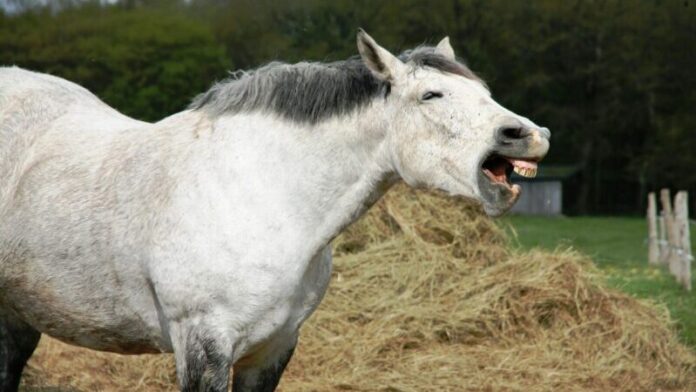If you have owned a horse long enough, there is a good chance that as it ages it will develop Intermediate Pituitary Dysfunction (PPID), better known as Cushing's Disease. This age-related endocrine disorder, which often occurs in horses over 15 years elderly but has been diagnosed in horses as youthful as seven, has no cure. If left undetected, it can lead to grave complications that can negatively affect your horse's quality of life.
Quarter Horse News spoke with Dr. Jen Voellinger of Precision Equine in Springtown, Texas, to learn what a diagnosis of Cushing's disease means for your horse.
The pituitary gland is the culprit
Older horses can benefit from regular veterinary visits. * Photo by Pexels
PPID occurs when a horse develops benign tumors in a section of the pituitary gland called the pars intermedia. These tumors cause an overproduction of hormones, which affects the horse's metabolic functions, blood pressure and electrolyte balance. This can lead to secondary complications such as heat intolerance, muscle wasting, weight loss, a suppressed immune system, chronic skin infections and general malaise.
PPID is not preventable; there are no supplements or medications you can give to ensure your horse does not develop it at some point in life. The only known significant risk factor is currently age, meaning any horse over the age of 15 can develop the disease. Therefore, as your horse gets older, it is vital to schedule regular check-ups with your veterinarian, who can watch for early signs.
“I always examine older horses for clinical signs of PPID,” said Voellinger. “Early detection and treatment are vital to reduce the negative consequences of the disease, such as infections and laminitis. This would improve the horse's quality of life and life expectancy.”
Common symptoms are not always seen
The most common symptom of Cushing's is a long, curly coat that doesn't shed well after winter. Many horses need to be clipped when temperatures rise because of the delayed shedding. Also look for muscle wasting, especially over the topline, increased thirst, excessive urination and decreased energy.
“Other less common signs may include abnormal sweating due to heat intolerance, exercise intolerance, a rounded belly, chronic skin infections and a broad, crested neck,” Voellinger said. “These can lead to complications such as higher parasite loads, recurrent infections, laminitis, foot abscesses and tardy wound healing.”
The most grave complication of PPID is laminitis, which is characterized by foot pain. In a horse with laminitis, the tissues that anchor the hoof wall to the underlying bone are weakened, causing the bone to rotate within the hoof capsule. This results in severe, chronic lameness from which some horses may never recover.
Screening tests are required for diagnosis
If your veterinarian suspects PPID based on your horse's clinical signs, he or she will perform some diagnostic tests. These include measuring baseline levels of adrenocorticotropic hormone (ACTH), which are usually elevated in horses with advanced Cushing's syndrome. Horses in the early stages of PPID may not yet have elevated levels, in which case your veterinarian may decide to start treatment anyway or order further tests such as the thyrotropin-releasing hormone (TRH) stimulation test.
Proper treatment of PPID can prolong a horse's life. * Photo by Helena Lopes via Pexels
Because PPID can occur with equine metabolic syndrome (EMS), it's vital to test for insulin dysregulation as well, Voellinger noted. EMS horses produce higher than normal insulin when they eat certain carbohydrates, and their insulin levels are tardy to return to baseline. They can have crested neck, like Cushing horses, and are also prone to developing laminitis. Unlike Cushing horses, most EMS horses are overweight, but thinner horses can still suffer from insulin dysregulation.
The prognosis depends on early detection
Just as there is no prevention for PPID, there is also no cure. However, PPID that is detected and treated early can have a good prognosis, depending on how well it can be controlled with treatment.
“PPID is treated with Prascend, the only drug approved for the treatment of PPID,” Voellinger said. “Horses that do not respond to high doses of Prascend may also require cyproheptadine or Periactin. Regular veterinary care, including dental exams, vaccinations, deworming and blood work, an appropriate nutrition and exercise program, and regular farrier services are key to a better prognosis for Cushing horses.”
Your horse's diet may need to be re-evaluated, especially if he also has EMS. Since many horses with PPID have difficulty maintaining their weight, a change in diet, such as switching to a complete senior feed, may be necessary, especially if your horse can no longer chew hay. Overweight horses may benefit from weight loss, which can improve their metabolism.
Careful treatment can extend the riding years
When show horses are well cared for and maintained throughout their lives, it is common for them to compete well into their delayed teens and twenties. Although Cushing's can complicate things, it does not have to mean the end of your horse's riding years.
However, a PPID diagnosis may require a change in the way you work with your horse, especially if he is suffering from temperature and exercise intolerance. You will also probably need to repeat the ACTH test to check that the medication is regulating the disease. Any changes in your horse's weight, coat, musculature or health should be reported to your veterinarian immediately.
“Care must be taken to properly care for and treat the horse, which may include changing the horse's training program or athletic requirements,” Voellinger said. “This protocol should be tailored to each horse and supervised by a veterinarian.”


